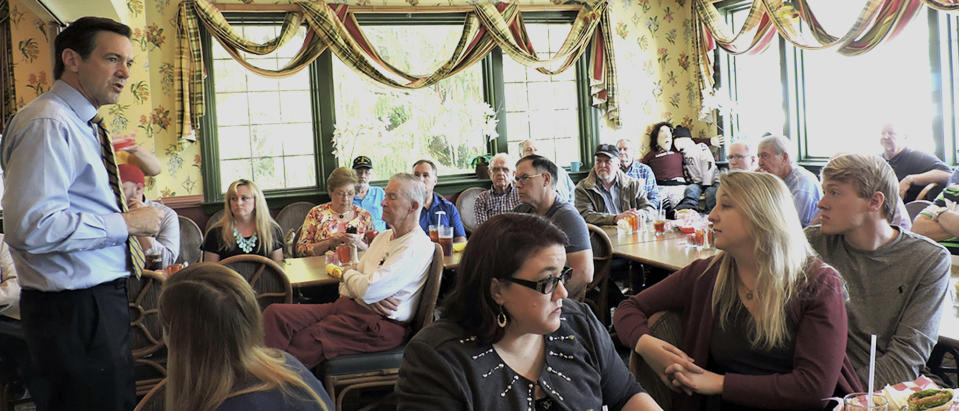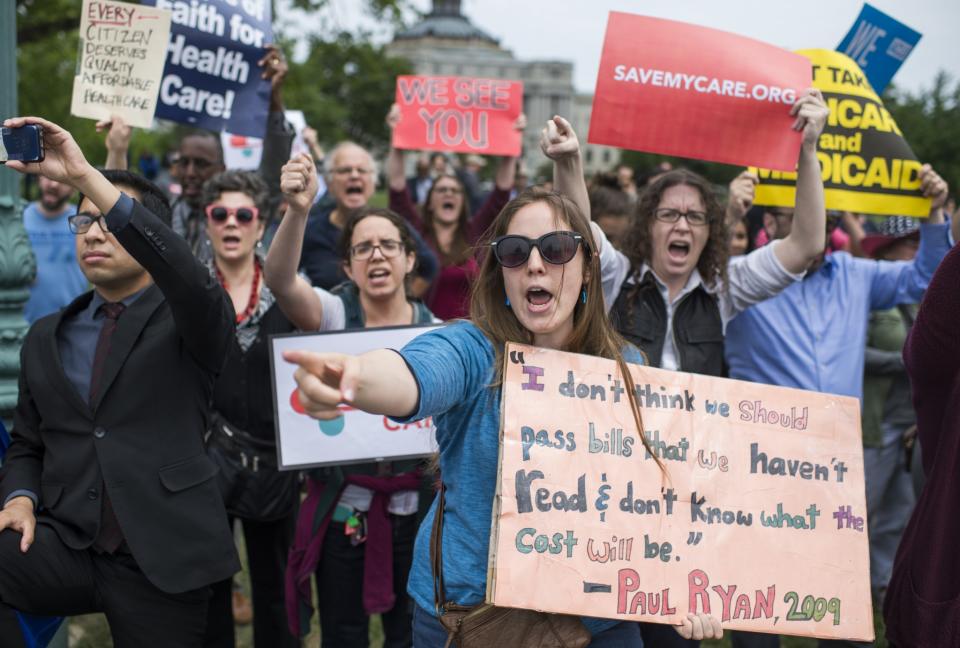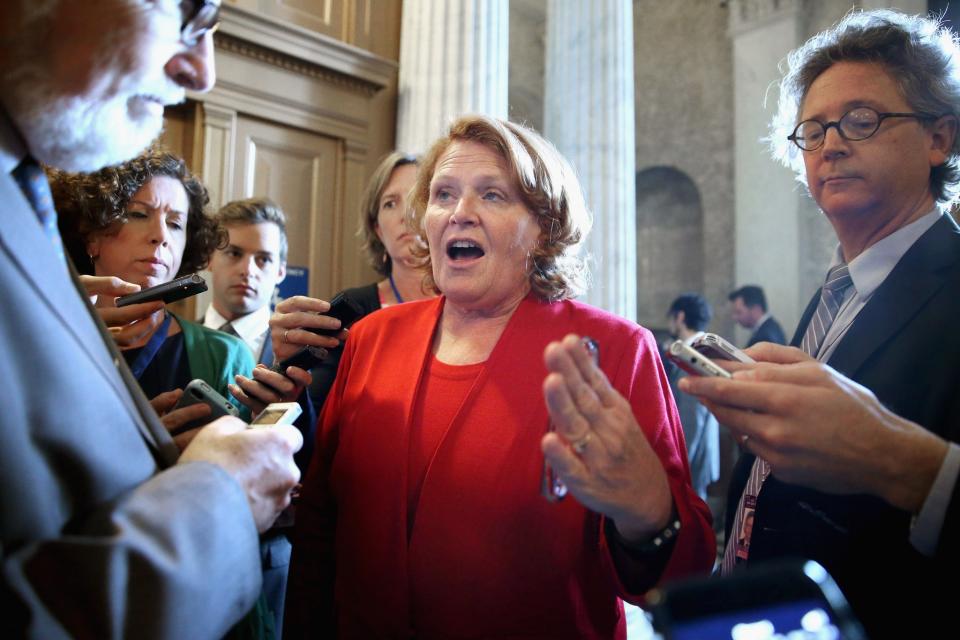The Trump effect shows Dems a path to putting the Senate in play

As the Trump-Russia investigation expands and Beltway insiders on both sides of the aisle begin to buzz about impeachment, the 2018 election is probably not the GOP’s No. 1 problem right now.
But outside Washington, the midterm jockeying is already well underway — and what was expected to be one of the most GOP-friendly Senate maps in decades is suddenly looking far less welcoming for Republicans.
“Don’t fall in love with the map,” Senate Majority Leader Mitch McConnell warned last month. “The map doesn’t win elections.”

It wasn’t supposed to be like this. Pundits have long predicted that Democrats would pick up seats in the House. But the Senate was a different story.
Twenty-five of the 34 seats that will be decided next year are currently held by Dems; 10 of them are in states that Donald Trump won in 2016. We’re talking about states where Hillary Clinton didn’t even come close, like West Virginia (Trump +42 percent), North Dakota (Trump +36 percent), Montana (Trump +20 percent), Indiana (Trump +19 percent) and Missouri (Trump +19 percent). And most of the Republicans up for reelection come from red states as well.
“Reeling Democrats confront brutal 2018 Senate map,” reads a Nov. 17, 2016, Politico headline. “A filibuster-proof majority isn’t out of the question if things break right for the GOP.”
“The 2018 Senate map just keeps getting better for Republicans,” added a Jan. 3 update in the Washington Post.
And yet, in recent weeks, the momentum seems to have shifted. Of course, Republicans could still win big on Nov. 6, 2018. A lot can change in 536 days — and no matter what happens between now and then, the Senate will be an uphill battle for Dems. But if current trends hold — if Trump and his party don’t right the ship — it’s possible they could not only squander a perfect opportunity to pick up seats, but they could also even imperil their majority.
For Democrats, retaking the Senate would require a net gain of three or more seats. Republicans now control the chamber by a 52-48 margin.
There are three factors the GOP needs to worry about.

The first is recruitment. Sure, a couple of serious Republican challengers have thrown their hats in the proverbial ring. In Ohio, state Treasurer Josh Mandel is gearing up for a rematch with Democratic Sen. Sherrod Brown, while in West Virginia, two-term Rep. Evan Jenkins announced his bid Monday against Democratic Sen. Joe Manchin.
But Mandel and Jenkins are the exceptions. In Wisconsin, Gov. Scott Walker and Rep. Sean Duffy have both declined to challenge Democratic Sen. Tammy Baldwin. In Michigan, none of the top three statewide elected Republicans — Lt. Gov. Brian Calley, Attorney General Bill Schuette and departing Gov. Rick Snyder — are expected to run against Sen. Debbie Stabenow, who will be seeking her fourth term. Montana Republicans were itching to see former Rep. Ryan Zinke go toe-to-toe with Sen. Jon Tester, but then Trump named Zinke secretary of the interior; no prominent Republicans have volunteered (yet) to take Zinke’s place. Meanwhile, Pennsylvania Rep. Pat Meehan, Indiana Rep. Susan Brooks and Ohio Rep. Pat Tiberi have all decided to skip this cycle’s Senate contest.
“Recruiting isn’t exactly what you’d want at this point,” a senior Republican strategist recently told RealClear Politics. “It’s not where it needs to be yet.”
“What compelling reason can anyone give me that this would be a good cycle to run for the United States Senate?” added another. “I don’t know what that is.”

Even the Republicans who plan to run could wind up being weaker than expected. That’s because a majority of them — potential candidates such as Kevin Cramer in North Dakota, Ann Wagner in Missouri, Lou Barletta in Pennsylvania, and Luke Messer and Todd Rokita in Indiana — are current House members who voted in favor of the GOP’s unpopular Obamacare repeal bill earlier this month. According to the latest poll, a full 52 percent of voters oppose the American Health Care Act; only 25 percent support it. Any Republican who voted “aye” on the AHCA is guaranteed to face a barrage of Democratic attack ads next fall.
The second factor the GOP needs to fret about is the relative strength of 2018’s Democratic incumbents. Indiana’s Joe Donnelly, North Dakota’s Heidi Heitkamp, Missouri’s Claire McCaskill, West Virginia’s Manchin, Montana’s Tester — all of them look vulnerable on paper. And they may be.
But remember: Incumbency is a powerful advantage, and the reason these Democrats were able to beat the odds and win in red states is that they were in tune with their constituents to begin with. According to Morning Consult, 60 percent of North Dakotans approve of Heitkamp; 57 percent of Montanans support Tester; and 57 percent of West Virginians approve of Manchin. Donnelly’s approval rating (46 percent) is 20 points higher than his disapproval number (26 percent), and even McCaskill, the least popular of the bunch, is above water (by 8 percentage points).

Heitkamp is a good example. In 2012, she won by a mere 2,881 votes. But since then, the freshman senator has voted to confirm Trump appointee Neil Gorsuch to the Supreme Court. She’s pro-gun, pro-coal, and pro-oil and -gas. As North Dakota Republican Brian Kalk, a former candidate for Congress, recently told the Associated Press, “there has to be an overwhelming reason for voters to leave her.”
Fundraising could be an issue as well. Thanks to Trump, Democratic donations are skyrocketing, and the party’s most imperiled Senate incumbents are likely to have plenty of money for the midterms. According to the AP, “McCaskill had raised $2.8 million as of last month and had more than $3 million in her campaign account. [Pennsylvania Sen. Bob] Casey has raised nearly as much, $2.7 million, and had $3.8 million in his campaign account. Brown had raised more than $2.4 million and had $5 million on hand, while Stabenow has raised $1.4 million and had a healthy $4.3 million banked. [And] in Florida, Sen. Bill Nelson had raised roughly $2 million through March, [with] roughly $3.6 million on hand last month.”
Which brings us, finally, to the third factor Republicans need to worry about: the president himself. A midterm election is almost always a referendum on the man in the Oval Office — and even in normal times, the day rarely goes well for his party.

These are not normal times. One hundred nineteen days into his presidency, Trump is under siege. His legislative agenda is stalled. Questions about his campaign’s possible collusion with Russia have consumed the national conversation; new reports surface daily about how he may have attempted to curtail or influence the ongoing investigations. His approval rating currently averages 39.4 percent — lower than any other president on record at the four-month mark. And those surveys were taken before this week’s damaging revelations had a chance to fully sink in.
The president’s popularity is the single biggest influence on a midterm election, and if Trump continues to crater, his party’s Senate majority could be at risk. In 2014 and 2016, conservative political analyst Sean Trende “used a simple model to show that Senate races can be predicted accurately using presidential approval, the partisanship of the state, incumbency and candidate quality.” The latest version of Trende’s model says that Democrats would likely take control of the Senate if Trump’s approval rating falls to 32 percent — a drop of 7.4 points from the current number. The way things are going now, that’s not impossible to imagine. Harry Truman, Richard Nixon, Jimmy Carter, George H.W. Bush and George W. Bush all slipped below the 30 percent mark during their presidencies.
Again, none of this is certain. Senate Democrats are still the underdogs, and that’s unlikely to change. But it’s worth noting that in 2012, the party was saddled with the same Senate map they’ll be saddled with in 2018 — and they managed to gain two seats regardless.
Recruitment played a role that year: Todd Akin lost to McCaskill in part because of his remarks on “legitimate rape”; Indiana’s Richard Mourdock faced considerable backlash for his ill-considered comments on abortion. The national political climate also contributed. Barack Obama won a fairly easy reelection fight against Mitt Romney, boosting down-ticket Democrats nationwide.

In that regard, 2012 might not look, at first glance, like a good model for 2018: More Democrats tend to show up for a presidential election than for a midterm. But motivation matters. If Trump doesn’t recover in time — and the riled-up Democratic coalition is just as inspired to vote against him as it was to vote for Obama — it’s possible that Democrats won’t just compete for control of House. They could upend the conventional wisdom and put the Senate in play as well.
_____
Read more from Yahoo News:



